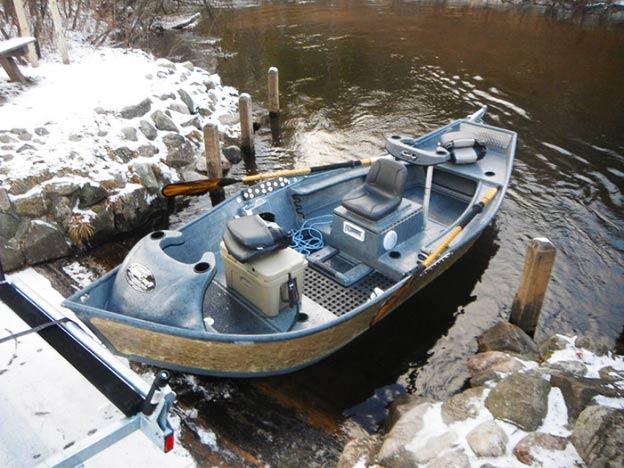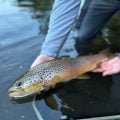How to Choose a Driftboat, Part I: Stealthcraft Aftermath
There comes a time in every angler’s life when he must face the truth, no matter what the cost. When he must admit to himself what needs admitting, no matter how much it complicates his life. When he must close the bathroom door, face the mirror square and say to the man reflected back at him:
“Friend, you need a new boat.”
Since making this admission a number of questions have flitted through my head. Driftboat or skiff? High profile or low? How many feet would I need? 14, 15, 16? Did I want motor capabilities? Finally, and least savorily: how much was I willing, or able, to pay?
Since I figure that there are probably several thousands of you in more or less the same position as myself, I decided I would narrate the entire process–from doing the research to towing one home. And so today we embark on this multi-part series, at the end of which, God willing, I will have a new boat in time for summer smallmouth, big water hex and mousing all the live-long night.
Since I live Michigan, I decided to start local and work my way west and south as necessary. For this first installment I interviewed Mike Batcke, owner of Stealthcraft Boats, a Midwestern company that each year eats a bigger piece of the national driftboat market pie.
MC: Let’s start by talking about what separates Stealthcraft from other companies.
MB: Well, there are a couple of things. One thing is that we’re really good at motors. No one else in the industry has really figured motors out yet. Every one of our boats accommodates one—they’ve got nice, wide transoms and diamond plate anchor mounts. It always seemed awful to me to ask someone to shell out $9000 and not give them a motor mount. It’s true that a number of other companies have horsepower ratings, but their boats are not designed to efficiently accommodate how a motor changes the way a boat performs on the water.
The other big difference is the material we use. In any boat design you can get rigidity and toughness with thickness, but that means weight. Which is why we use a Plascore Honeycomb Core to allow for more thickness without the extra weight. As a result, our boats are 100 pounds lighter than any of our competitor’s, and tougher than an aluminum boat.”
A key element of Plascore is that it does not absorb water. If a normal gel coat is compromised, that scratch or ding will suck outside water into balsa, making it much heavier and ultimately leading to failure. There’s no natural floatation. Not so with Plascore. Here’s an experiment: take a competitor’s boat with torn-up chines and sit it in a pond for two months. It’ll sink. That’s because polyester resin is only 70% water resistant. Epoxy and vinyl ester resin, on the other hand, is 90% resistant. That’s the great thing about Plascore—once you get through the gelcoat and that layer of glass, it’s plastic. It floats.
All this is significant because in 2014 the Coast Guard is going to mandate floatation on any boat labeled as “motor-ready.” That’s going to be a problem for a lot of companies that build fiberglass boats with horsepower ratings. Those guys will either have to drop the horsepower rating or fill a bunch of stuff with foam. Of course, the problem with foam is that once the skin is compromised, it absorbs water.
MC: Why did you want to start designing boats?
MB: At the time we decided to really do this I was a guide with a degree in naval engineering. We wanted to build boats that fish. If you look at our interiors, they’re dialed in. Everyone loves them. It’s a completely open design. Also, because of our construction process, the boats are structurally self-contained. Other boat companies, which by and large just pop a form out of a mold, their boats would fall apart without that interior—it’s the interior that holds their boats together. That’s not the case with our boats—they have total structural integrity.
MC: Your boats are acquiring quite a following. What is it you think people are responding to?
MB: One things is how well they row. When you get on our boats and you move the oars, the boat moves. It’s really responsive. Compare this to, say, a Clackacraft. Clackas are so durable because the whole boat flexes. That flex makes them really durable. The trade-off is rowability, since the boat gives a little when you jam on the oars. Not so with our boats. You move the oar, the boat moves.
Also, all of our boats are short and squatty with a high rocker, so when you back row that boat stays right where you want it to stay, no matter what kind of load you’re carrying. On the opposite end of the spectrum you’ve got skiffs. They don’t backrow that well—especially when loaded. It’s that low rocker. Of course, they push-row well because they’re like a canoe. But get three big dudes on there in heavy water, and you’re asking for trouble.
MC: What’s the production side of things like at Stealthcraft? How many boats do you put out a year?
MB: We use a different building process than a lot of our competitors—we’re not just popping boats out of a mold. Working with Plascore takes longer. A lot of people will ask me what the difference is between my boat and a boat by another company. It’s like asking about the difference between a Cavalier and a Porsche. One is trying to satisfy production, the other quality. A boat that takes another company 2 days takes us 5 days.
Another important production component is that we don’t just know driftboats and sleds. We know all boats. Half of our business, in fact, is building racing hulls. We had three boats in the America’s Cup last year. We know speed.
Our production and our margins are growing, too. We’ll build 170 boats this year. Last year we built 106. In terms of where we’re selling the most, Idaho and Montana are still 1 and 2.
MC: You’re up to 18 models now, and your models have changed quite a bit over the last eight years. How do your designs evolve?
MB: We keep getting better. A lot of companies will have one mold. They’ll change one thing and spend the rest of their money on marketing. They’re big companies. They’ve got a lot invested in their production line. They’ve got a lot of reasons not to change or innovate. We spend some money on marketing, but for the most part we’re driven by design and innovation. My thought is: Build it and they will come. We’re constantly refining, changing the jig, changing the way we approach things. We’ll ask ourselves: What didn’t we like about this? How can we tweak that? Our designs have really evolved from 12 foot to 16 drift boats and 18 foot All-Terrain Boats.
One feature you’ll notice in all our boats is the wide hull. It’s more stable. It’s not tippy. You won’t need to ask people to lean the other way when you have to “do your thing.” You can stand on the gunnels and jump on our boats and water will not pour in. Other companies don’t widen because, again, they’re too production laden and would have to change too much–their trailers, for instance. If they widened their hulls they’d have to completely revamp their trailers. So it’s true here as in other industries: the bigger you are, the harder it is to change. But at Stealthcraft, we’re adaptable. We change. We refine. We’re more design orientated than production laden at this point.
MC: What would you tell a first time boat buyer about choosing a drift boat?
MB: Compare, compare, compare. And not just superficially. You need to look beyond the numbers. The manufacture specs you find on websites don’t tell the whole story. We build wide hulls, for example, and it makes a huge, huge difference in terms of square footage. If you put our 15 foot Aftermath and a 16 foot Clackacraft on the CAD machine, you’ll see our interior has more square footage. A lot more space.
A lot of companies talk about the durability of their boats. Durability is great. But I’m a naval engineer. Building something not to break is just not enough. Engineering has come a long way, and I wanted to take advantage of the new capacities.
MC: Bottoms are a big deal in a boat that’s going to take as much abuse as a driftboat. What kind of bottom options do you offer?
MB: You can go a couple routes. Our standard bottom comes with a teflon additive to the gelcoat Also standard is the keelguard. The chine guards we use are from a company in Utah.
The next step up in terms of bottom options is our truck bed liner bottom. It’s the most durable—a good choice for guys who are really hard on stuff. The only disadvantage is it’s sticky.
Our best bottom is the UHMW with a keelguard wrapped around the chines. It’s the same technology you find on skis and snowboards. We vacuum bag it on. It’s an expensive option. It’s also something that’s harder to fix if something goes wrong.
MC: If I were to ask you to articulate “the Stealthcraft” philosophy, what would you say?
MB: We do what we do in order to create a superior fishing vehicle, not to make the cheapest product we can. We ask ourselves: What can we do to catch more fish?
That’s why we offer the camouflage finish. Sure, yellow, turquoise, is cool. It can look pretty. But we wanted something that blends in. Something that lets you sneak up on your fish. That’s another reason Plascore is so great: it’s the quietest thing on the market. It deadens sound. That deadening effect has one negative that I’ll mention. If you’re out in the winter and it’s snowing a ton, that snow is not going to melt, because the temperature of the water is not coming through the boat.
We also want to make fishing more efficient, more convenient, more fun. Me, for instance, I hate taking rods out of my boat at the end of the day. So I put eight rod holders in the boat. And a whole lot of other storage to boot. You can be at the end of the day on your boat, and still have everything ready for tomorrow. Headlights are another thing. A lot of guys in Michigan like to fish in the dark, hexing and mousing. Now you don’t need a guy on the bow with a flashlight. You flick the switch and boom, you can see where you’re rowing at 2 in the morning.
After the interview we hit the water in the 15 foot Aftermath, which felt a good deal roomier than the 16 foot boat I had thrown streamers out of the day before. I had visions of a three-day musky float down a wild Northern Wisconsin river; my fishing buddies and I would not want for space. The boat does indeed backrow like a dream, and I was able to maneuver it around fresh deadfalls that would have been tricky even with my 13 foot Dave Scadden raft. It was also as stable as any boat I’d ever been in, if not more so. Mike actually hopped up onto the gunwale and rocked the boat with all his might–definitely not a tippy boat.
So there I had my first round of data. This was an incredible drift boat, particularly for “real” water. I would never be limited in terms of where I fished–the boat could handle most everything the West and Midwest could throw at it. I would also never be limited in terms of company–even the 15 foot Aftermath easily seats 4. A part of me wanted to put a down payment on the boat right then and there. But there were other manufacturers to talk to, and other possibilities to imagine. How, for instance, might a skiff fit into my fishing lifestyle? In the next installment I’ll be talking skiffs with Capt. Todd Gregory of Towee Boats.
Stay tuned.















